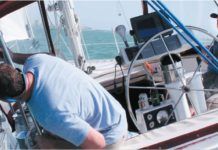The Ultimate Test Boat
Ive been the fortunate witness to the rebirth of a boat and the inspiring maturation of a boy. And Practical Sailor readers have unknowingly been along for the ride. For the past five years, boatbuilder Robert Helmick has allowed his Endeavour 42 Lost Boys to serve as a test platform for a wide array of sailing gear featured in these pages.
Mailport: Water Lift Muffler, Drogues, Hunter 30, and More!
After corrosion destroyed the water-lift muffler aboard his 1972 Irwin 37 (above) and he could not find a replacement, subscriber Gene Millard fabricated his own.
Stiletto 27: The Beachcat Grown Up
Its hard to mistake the Stiletto 27s appearance-typically with blazing topside graphics and aircraft-style, pop-top companionway hatches. Its also hard for the average sailor to appreciate the sophistication of the Stilettos construction-epoxy-saturated fiberglass over a Nomex honeycomb core. There is probably no production hull built in the U.S. with a better strength-to-weight ratio than the Stiletto. And although the design is 40 years old, the Nomex honeycomb fabrication is still impressive.
Stiletto Foiler on Horizon
This summer, Stiletto Manufacturing will be launching the all-new Stiletto X-Series, including a foiling catamaran, with the first boats expected to splash about the time this article went press. Carrying on the Stiletto tradition, the 10-meter X-Series models are being marketed as high-performance boats that are fast, beachable, trailerable, and affordable, as well as easy to handle and ideal for coastal family getaways.
The 70s Dream Endures: Hunter 30
If you grew up sailing in Florida in the 1970s and 80s as I did, you probably spent many hours daydreaming and looking at Hunters, or if you were fortunate, sailing one. Those memories might not exist at all were it not for bit of luck and perseverance. While the U.S. economy was caught in a global recession, the Hunter Marine plant in Florida was still churning out sailboat hulls by the dozens.
Columbia 8.7
For better or worse, the Columbia 8.7 is modern in appearance, with a very straight sheer, pronounced forward overhang, and no overhang aft. The stern is decidedly unusual, with an exaggerated wineglass-section transom. This reduces the apparent size of the back end of the boat, which would otherwise look very ungainly since beam is carried well aft. From an aesthetic point of view, you either like the stern or you don't.
Dragonfly 800
The Dragonfly 800 comes in two configurations, one for racing and one for what the company calls cruising, which is a misnomer only in that it implies a plodding demeanor, which is hardly the case. The essential difference is a taller mast and Kevlar sails for the racing model.
EXPO Solar Sailer
The EXPO Solar Sailer was conceived by Hoyt (who has a long list of conceptions to his credit), designed by Hood (who needs no introduction) and built by TPI(at present, or one time or another, the builder of J Boats, Aldens, Jeanneau catamarans and Freedoms). Put Gary Hoyt, Ted Hood and Everett Pearson in a canoe and you have the marine industry's maximum tripartite brain power. The cerebral sparks from these three New England dynamos produced the EXPO Solar Sailer.
Island Trader 37/38
In profile, the Island Trader 37 looks like she caught a wave on the chin. The sheer seems exaggerated, rising too high in the bow and stern. The low-aspect rig is short, carrying just 567 square feet of sail on a 30' 4" waterline. Displacement is reported anywhere from 18,600 lbs. to 26,400 Lbs. This gives the 37 an incredible displacement/length ratio of 422, and an abominable sail area/displacement ratio of 10.7, easily putting it in the "heavy" or "motorsailer" category.
Tripp 26
This 26-footer is totally unlike familiar racer/cruisers from Pearson, Catalina or Hunter. For openers, it looks like a hot rod. The fine entry of its plumb bow and reverse transom give it a grand prix look, as does its 8' 8" beam. The boat displaces only 2,900 pounds on a 22' 0" waterline. It has a 7/8 rig supported by a pair of swept-back spreaders. Standing rigging is 3/16" wire on the uppers, forestay and lowers, 5/32" on the intermediates and running backstays. Ease of movement along wide decks is assisted by inboard shrouds.














































